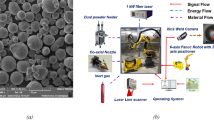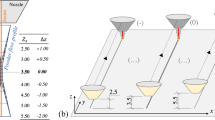Abstract
Advancements in additive manufacturing (3D printing) have enabled researchers to create complex structures, offering a new class of materials that can surpass their individual constituent properties. Selective laser sintering (SLS) is one of the most popular additive manufacturing techniques and uses laser power to bond powdered material into intricate structures. It is one of the fastest additive manufacturing processes for printing functional, durable prototypes, or end-user parts. It is also widely used in many industries, due to its ability to easily make complex geometries with little to no additional manufacturing effort. In the SLS process, tool path selection is important because it is directly related to the integrity of a 3D printed structure. In this research, we focus on how to obtain an optimal tool path for the SLS process from a numerical simulation. Also, we apply a deep learning technique to accelerate the simulation of the SLS processes, while obtaining accurate numerical results.






















Similar content being viewed by others
Availability of data and material
All the relevant data and the material is available at https://github.com/kdhoon2/SLS_DHKIM.
Notes
PA12 is a widely used thermoplastic material for selective laser sintering which is suitable for many applications [1].
Selective laser sintering (SLS) processes heat the powdered material below its melting point so that the powder can fuse together at a particle level. In selective laser melting (SLM), however, the powdered material is not merely fused together but is fully melted. While the SLM normally works with metals, the SLS generally works with plastics and ceramics.
One could use a micro-scale particle-based model to include the expression for the estimated extinction coefficient.
It is hard to say that the given configuration of the hyper-parameters is the optimal choice for the deep learning model. One could try optimizing hyper-parameters by using optimization techniques such as Bayesian optimization, evolutionary algorithms, or gradient-based optimization.
References
Aldahash SA (2018) Optimum manufacturing parameters in selective laser sintering of PA12 with white cement additives. Int J Adv Manuf Technol 96(1–4):257–270
Steen WM, Mazumder J (2010) Laser material processing. Springer, Berlin
Zeng K, Pal D, Stucker B (2012) A review of thermal analysis methods in laser sintering and selective laser melting. In: Proceedings of solid freeform fabrication symposium Austin, TX, vol 60, pp 796–814
Dong L et al (2009) Three-dimensional transient finite element analysis of the selective laser sintering process. J Mater Process Technol 209(2):700–706
Kolossov S et al (2004) 3D FE simulation for temperature evolution in the selective laser sintering process. Int J Mach Tools Manuf 44(2-3):117–123
Matsumoto M et al (2002) Finite element analysis of single layer forming on metallic powder bed in rapid prototyping by selective laser processing. Int J Mach Tools Manuf 42(1):61–67
Simchi A (2006) Direct laser sintering of metal powders: mechanism, kinetics and microstructural features. Mater Sci Eng A 428(1–2):148–158
Simchi A, Pohl H (2003) Effects of laser sintering processing parameters on the microstructure and densification of iron powder. Mater Sci Eng A 359(1–2):119–128
Gusarov AV, Kruth J-P (2005) Modelling of radiation transfer in metallic powders at laser treatment. Int J Heat Mass Transf 48(16):3423–3434
Gusarov AV et al (2009) Model of radiation and heat transfer in laser-powder interaction zone at selective laser melting. J Heat Transf 131(7):072101
Ganeriwala R, Zohdi TI (2014) Multiphysics modeling and simulation of selective laser sintering manufacturing processes. Procedia CIRP 14:299–304
Zohdi TI (2013) Rapid simulation of laser processing of discrete particulate materials. Arch Comput Methods Eng 20(4):309–325
Zohdi TI (2014) Additive particle deposition and selective laser processing-a computational manufacturing framework. Comput Mech 54(1):171–191
Zohdi TI (2014) A direct particle-based computational framework for electrically enhanced thermo-mechanical sintering of powdered materials. Math Mech Solids 19(1):93–113
Zohdi TI (2017) Modeling and simulation of laser processing of particulate-functionalized materials. Arch Comput Methods Eng 24(1):89–113
Ganeriwala R, Zohdi TI (2016) A coupled discrete element-finite difference model of selective laser sintering. Granular Matter 18(2):21
Zohdi TI (2018) Dynamic thermomechanical modeling and simulation of the design of rapid free-form 3D printing processes with evolutionary machine learning. Comput Methods Appl Mech Eng 331:343–362
Weinan E, Han J, Jentzen A (2017) Deep learning-based numerical methods for high-dimensional parabolic partial differential equations and backward stochastic differential equations. Commun Math Stat 5(4):349–380
Cai Z et al (2020) Deep least-squares methods: An unsupervised learning- based numerical method for solving elliptic PDEs. J Comput Phys 420:109707
Weinan E, Yu B (2018) The deep Ritz method: a deep learning-based numerical algorithm for solving variational problems. Commun Math Stat 6(1):1–12
Mohan AT, Gaitonde DV (2018) A deep learning based approach to reduced order modeling for turbulent ow control using LSTM neural net- works. arXiv preprint arXiv:1804.09269
Wang Z et al (2018) Model identification of reduced order UID dynamics sys- tems using deep learning. Int J Numer Meth Fluids 86(4):255–268
Bertsekas DP et al (1995) Dynamic programming and optimal control. Athena Scientific, Belmont
Bellman R (1966) Dynamic programming. Science 153(3731):34–37
Howard RA (1960) Dynamic programming and Markov processes
Bellman RE, Dreyfus SE (2015) Applied dynamic programming. Princeton University Press, Princeton
Hecht J (2018) Understanding lasers: an entry-level guide. Wiley, Hoboken
Rombouts M et al (2005) Light extinction in metallic powder beds: correlation with powder structure. J Appl Phys 98(1):013533
Valueva MV et al (2020) Application of the residue number system to reduce hardware costs of the convolutional neural network implementation. In: Mathematics and computers in simulation
LeCun Y et al (1989) Backpropagation applied to handwritten zip code recognition. Neural Comput 1(4):541–551
Y LeCun, Y Bengio et al (1995) Convolutional networks for images, speech, and time series. In: The handbook of brain theory and neural networks, vol 3361, no 10
LeCun Y et al (1998) Gradient-based learning applied to document recognition. Proc IEEE 86(11):2278–2324
Goodfellow I, Bengio Y, Courville A (2016) Deep learning. MIT Press, Cambridge
Mitchell RS, Michalski JG, Carbonell TM (2013) An artificial intelligence approach. Springer, Berlin
Murphy KP (2012) Machine learning: a probabilistic perspective. MIT Press, Cambridge
Langley P et al (1994) Selection of relevant features in machine learning. In: Proceedings of the AAAI fall symposium on relevance, vol 184, pp 245–271
Kononenko I, Kukar M (2007) Machine learning and data mining. Horwood Publishing, Cambridge
Gu GX, Chen CT, Buehler MJ (2018) De novo composite design based on machine learning algorithm. Extreme Mech Lett 18:19–28
Chen C-T, Gu GX (2019) Machine learning for composite materials. MRS Commun 9(2):556–566
Y Kim et al. (2020) Designing adhesive pillar shape with deep learning-based optimization. ACS Appl Mater Interfaces
K He et al. (2016) Deep residual learning for image recognition. In: Proceedings of the IEEE conference on computer vision and pattern recognition, pp 770–778
Guzella TS, Caminhas WM (2009) A review of machine learning approaches to spam filtering. Expert Syst Appl 36(7):10206–10222
Santos I et al. (2009) Machine-learning-based mechanical properties prediction in foundry production. In: 2009 ICCAS-SICE. IEEE, 4536–4541
Mannodi-Kanakkithodi A et al (2016) Machine learning strategy for accelerated design of polymer dielectrics. Sci Rep 6:20952
Pilania G et al (2020) Data-based methods for materials design and discovery: basic ideas and general methods. Synth Lect Mater Opt 1(1):1–188
Oishi A, Yagawa G (2017) Computational mechanics enhanced by deep learning. Comput Methods Appl Mech Eng 327:327–351
Paszke A et al (2019) Pytorch: an imperative style, high-performance deep learning library. In: Advances in neural information processing systems, pp 8026–8037
Glorot X, Bengio Y (2010) Understanding the difficulty of training deep feedforward neural networks. In: Proceedings of the thirteenth international conference on artificial intelligence and statistics, pp 249–256
Kingma DP, Ba J (2014) Adam: a method for stochastic optimization. arXiv preprint arXiv:1412.6980
Wilt JK, Yang C, Gu GX (2020) Accelerating auxetic metamaterial design with deep learning. Adv Eng Mater 22:1901266
Kim DH, Zohdi TI, Singh RP (2020) Modeling, simulation and machine learning for rapid process control of multiphase owing foods. Comput Methods Appl Mech Eng 371:113286
Acknowledgements
This research was supported by Samsung Scholarship. Also, the first author, Dong Hoon Kim, thanks Euihyun Choi for providing valuable thoughts on tool path generation.
Funding
This research was supported by Samsung Scholarship.
Author information
Authors and Affiliations
Corresponding author
Ethics declarations
Conflicts of interest/Competing interests
Not applicable
Code availability
The simulation code is available at https://github.com/kdhoon2/SLS_DHKIM.
Additional information
Publisher's Note
Springer Nature remains neutral with regard to jurisdictional claims in published maps and institutional affiliations.
Rights and permissions
About this article
Cite this article
Kim, D.H., Zohdi, T.I. Tool path optimization of selective laser sintering processes using deep learning. Comput Mech 69, 383–401 (2022). https://doi.org/10.1007/s00466-021-02079-1
Received:
Accepted:
Published:
Issue Date:
DOI: https://doi.org/10.1007/s00466-021-02079-1




